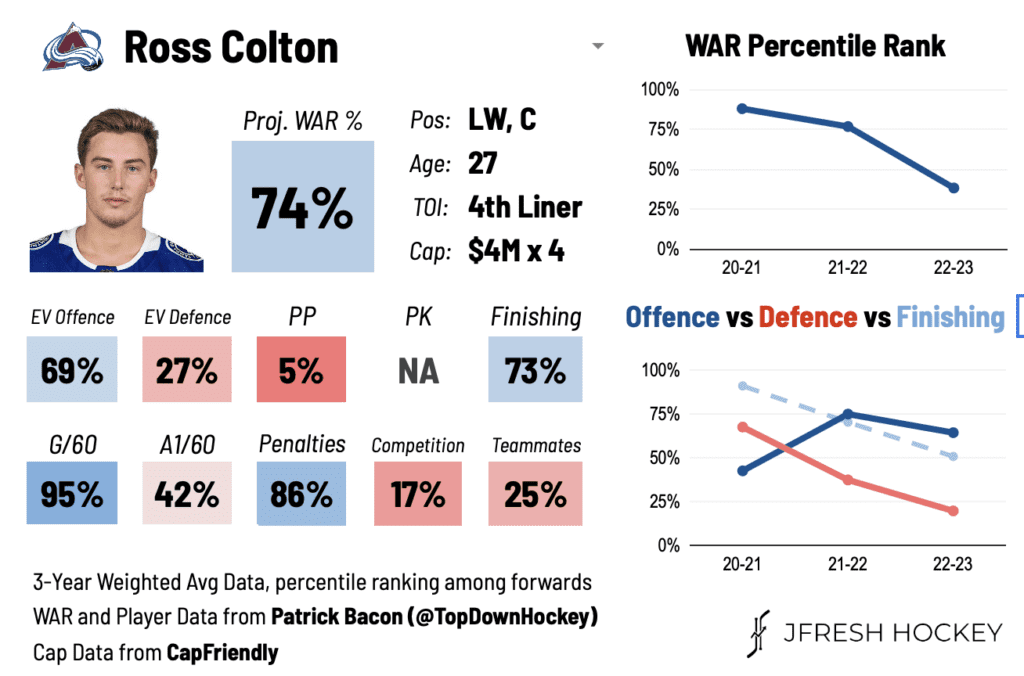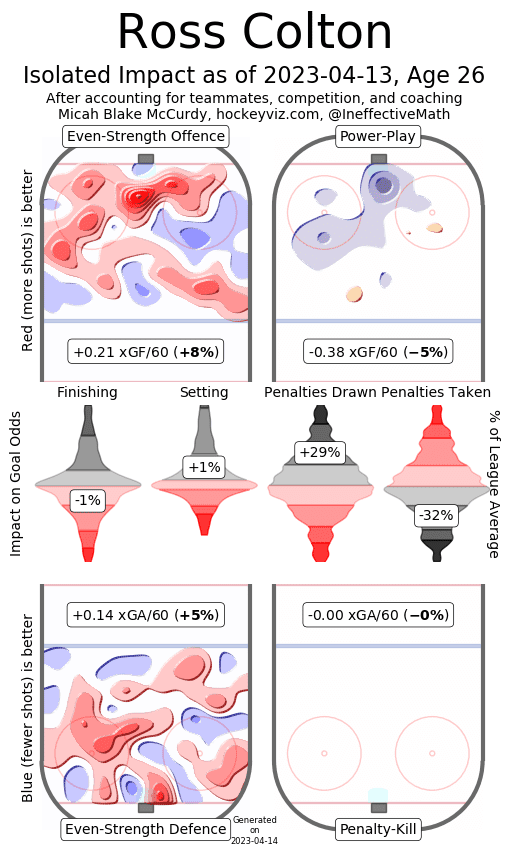Colorado Avalanche
ANALYSIS: Why The Avalanche Are Betting Big On Ross Colton

When the Colorado Avalanche announced a four-year contract for Ross Colton on Monday, the least surprising part of it all was the four-year part.
After all, the Avalanche had clearly targeted the 26-year old forward when they traded for him last month. After the Miles Wood contract, you knew term was going to be on the table.
The money part? That may have caught some people (myself included) by surprise, but when you dig a little deeper, you can see why the Avalanche are betting big on Colton in an increased role.
The Numbers


Like Miles Wood, the numbers don’t look great in his own end. And just like Wood, he doesn’t kill penalties. I expect him to get that opportunity with the Avalanche, but he’s an unknown there. It should be noted that like most players, the majority of his shifts started in the neutral zone, and he only started 14 more shifts in the offensive zone compared to the defensive zone. Not a huge discrepancy there.
Where Colton really stands out is in the offensive zone, and it’s pretty easy to see why the Avalanche are banking on that production increasing with a bigger role.
On the Lightning, Colton finished 10th in even strength average time-on-ice at just under 11 minutes a game. His expected goals-per-6o was 1.01, good for fourth-best on Tampa. That means he’s awfully efficient when it comes to goal scoring in pretty limited ice time. For comparisons sake, that’s higher than every single regular forward on the Avalanche last season. A lot of his goals come in and around the net, something the team has missed a bit of without Landeskog in the lineup.
We touched on it after the trade, but Colton generates shots like a mad man. With 15.11 shot attempts-per-60, and 8.3 shots on net-per-60, he was right up there with Nikita Kucherov in terms of shot generation. And while his defensive metrics aren’t great, the Lightning controlled nearly 53% of the shot attempts with him on the ice, good for sixth-best in their forward group. This is all in pretty limited ice-time.
Are you sensing a pattern here? Like Wood, the Avalanche are seeing a player who performed well in a smaller role in the areas they like, and they think that will only get better in an increased role. Colton, however, seems like much more of a sure thing than Wood, as his numbers are a heck of a lot more encouraging. Shot generation and goal production were major issues for the bottom fix, and the acquisitions of Wood and Colton should go a long way in helping fix that problem.
The Fit
Joe Sakic said they wanted to get “a little grittier” this off-season, and they’ve done that with the acquisition of Colton.
Colton averaged 12.28 hits-per-60 in Tampa Bay last year. The Avalanche did not have a single regular forward anywhere near that number. He also scores a good majority of his goals from in and around the net, something the bottom fix was lacking last season. It’s clear the organization wanted to make a change to how the bottom of their lineup operates, and on paper, they’ve accomplished that goal.
So Colton scores goals at a high rate, crashes the net, digs pucks out of the corners, throws his body around with reckless abandon, and has performed well in the playoffs. Where are the question marks?
The biggest one might be how he transitions to the center position full-time, because Chris MacFarland has indicated that’s where they want him to play. He mostly played wing last season in Tampa, but the year before, was used more extensively at center. That could be a big reason why they targeted him. His best season in the NHL came when he spent more time at center, so they’re banking on the transition being fairly easy. I’m not very concerned about his ability to transition back to center personally, but it’s worth mentioning.
In the face-off circle, he’s done quite well for himself, as he sits at just over 52% in the 1,000 or so face-offs he’s taken in the NHL. Not bad, and with Ryan Johansen joining the team, the Avalanche should be a lot better in that area.
Colton’s actual on-ice production took a step back last season, as he dropped from 2.15 to 1.55 in terms of points-per-60. That’s about the same level of production the Avalanche got from Alex Newhook last year, but it really comes down to what they value in the 3C role. Colton’s ability to forecheck, generate shots, and dig for pucks would seem to be a more natural fit in that 3C spot.
The other two question marks would probably be his puck distribution and defensive acumen. Colton has not been much of a puck distributor at the NHL level, so if Johansen doesn’t work at 2C, could Colton step in? He might not be a natural fit there, but would be interesting to watch. Wood and Colton should make up 2/3 of the third line, and would benefit from a distributor on their line. If Jonathan Drouin doesn’t click immediately with MacKinnon, playing with Wood and Colton may be his best chance to provide value for the team.
And can Colton handle some more defensive responsibility? Like I mentioned before, he hasn’t killed penalties much at the NHL level, but that doesn’t mean the Avalanche won’t try him there. Colorado has a blueline that makes life pretty easy for the forwards, so he’ll have help, but Tampa didn’t exactly have a bad defense themselves.
The Contract
Four years is perfect. It takes Colton to 30, and you’re not giving too much term to a bottom six forward. He’ll have a NTC in year 2, and a modified NTC in years 3 and 4, and the Avalanche have been more willing to give those out in recent years.
The money is a little more than expected, but not a total surprise. Arbitration gave Colton some leverage, as he would have been rewarded a one-year contract that took him straight to unrestricted free agency. That would not have been good for the Avalanche, so they upped the dollar amount to get the deal done. Colton will take up 4.79% of the cap this year, but all indications are that the salary cap will rise significantly over the next two seasons.
The Verdict: B+
I loved the trade, and have no real issues with the contract. It’s a little more than I expected, but not a massive overpay by any means. If Colton returns to his 20 goal form, it will look just fine.
Stylistically, I think he’s a tremendous fit in the lineup. MacFarland and the rest of management were clearly unhappy with how the season ended, and the lack of production (and fight) from the bottom six was a big reason for their exit in round one. Colton brings a lot of what they were lacking in the postseason.
Management knew what they needed to address, and found a great fit for their third line.












